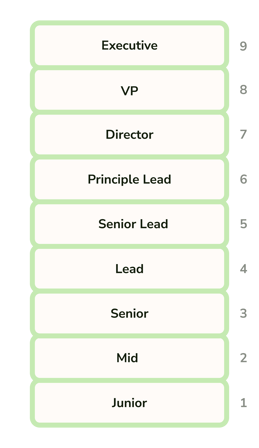
An Introduction to Progression Frameworks
Let's talk about Progression Frameworks - because regardless of your company's size, funding, or maturity, the ability to outline structured growth and development for your employees can make or break an organization.
When you're in a hyper-growth phase, or your internal talent team is tight on resources, anything other than filling roles can feel like an afterthought.
Building leveling frameworks, compensation models, progression plans, and development programs can be easy to put off - but the reality is that you need to be on top of this even when you're a team of 1.
But what do these initiatives consist of, exactly? And how do you go about "building" them?
In this article, we'll get into the nitty-gritty of progression frameworks and the intricacies that come along with it as your company grows and matures.
Why are we honing in on progression frameworks in particular? Because regardless of your company's size, funding, or maturity, the ability to outline structured growth and development for your employees can make or break an organization.
So, let's get into it.
Understanding Progression Frameworks
HR is filled with lingo - so, first things first, let's get some definitions out of the way.
What is a progression framework?
As the name suggests, a progression framework is a clear outline and plan for how employees can progress within your company.
Progression frameworks are structured models that outline the skills, knowledge, behaviors, and experiences required for career advancement within your company. They provide your employees with a clear career development roadmap and a framework to gauge their current skill set, identify areas for improvement, and see a future for themselves in your organization.
It's a no-brainer that progress is critical to the success of any company and the happiness of a majority of employees - but without a clear framework to progress in, moving towards your goals can feel chaotic, misaligned, and eventually stalled.
Benefits of Implementing Progression Frameworks
As we said, implementing a progression framework is a no-brainer. But let's get into why it should be such an obvious priority.
- Establish transparent career paths for employees. Progression frameworks offer a clear path to career growth. Getting "career clarity" lets them visualize the skills and competencies required to advance to the next level, helping them set achievable career goals. It also materializes a future for them in the company - and when they can see a future for themselves, they are more likely to hang around. This means another benefit of career clarity is, you guessed it, improved retention.
- Objective performance measurement and evaluation. We talk a lot about bias in the recruitment process, but discrimination doesn't stop once a hire is made. Promotion bias is very real, but establishing objective performance criteria can help reduce this bias by objectively evaluating employees for promotions. Have they met the requirements set for everyone? Are they objectively ready to take the next step in their career based on experience? A solid progression framework will help you answer these questions.
- Focused skill development. In organizations with progressive frameworks, employees have a structured path for skills development. So, no matter if they have been in their role for five years or five minutes, they know what success looks like in that role and then one after. This allows them to hone in on the skills most important for the role rather than going rogue and spending time and budget on skills that won't further their career.
- Tailored Learning and Development: Progression frameworks guide an employee's learning journey. By knowing what skills they need to progress down which path, employees can choose training, certifications, or experiences that align with the competencies required for their desired career stage. This not only makes development more efficient and effective, but it also puts learning and development back into the hands of the employees.
- Room to grow. Establishing a career and progression framework in the early days allows you to expand levels, tweak skills, and adjust salaries as you grow and mature. Most importantly, it also gives your employees room to grow and add value throughout their careers.
- Enhancing employee satisfaction and retention rates. This is a bit of an accumulation of the previous points, but it's nonetheless worth mentioning. Successful implementation of a progression framework will enhance employee satisfaction and retention rates. Period. Having employees who know what success looks like, know where their careers are headed, and know they have the freedom to explore new opportunities at their current company will directly and positively influence retention and satisfaction.
Components of a Progression Framework
No matter the solid progression framework consists of four key components: Levels, roles, skills, and competencies.
- Competency Levels: Progression frameworks define different competency levels, from entry-level to expert. Also referred to as simply "levels," these serve as milestones to measure progress, all the way from Intern to CEO.
- Roles: It's a given that you have varying roles within a given level. For example, you will have a VP Product, VP Sales, VP Marketing, and so on. If your leveling framework extends that far, you'll also have the same setup for Interns, Managers, or even C-Suite. Roles typically correlate with departments, so while some departments might have a role for every level, others may not. This all depends on the maturity of the department. For example, your product team might have 30+ positions spread across five levels. In comparison, your Talent Team might only have two people (i.e., one at a senior level and one at a junior level).
- Core Competencies: They outline the fundamental knowledge areas and behaviors essential for success in the field (i.e., analytical aptitude, negotiation skills, etc). These competencies are core to the role at hand and can be measured through assessment tools and past performance.
- Specialized Skills: As employees progress through different levels, they'll encounter technical skills and expertise relevant to their role. For someone working in Talent Acquisition, this might include knowing how to design a sourcing strategy, being trained in candidate assessment, or being compliant with hiring regulations in different markets.
Steps to Designing an Effective Progression Framework
To summarize, a good progression framework consists of levels, competencies, roles, and skills - all of which outline how any given employee can progress within your organization.
Now that we have the basics covered, let's get into how you can build- or improve - a progression framework for your organization.
Evaluate your current framework
Do you already have a progression framework in place? Great! Let's start there.
If you don't already have one in place, skip to the next section about defining levels and competencies.
If you already have a progression framework, start by gathering employee feedback to assess its effectiveness (i.e., sending a survey or conducting interviews). Do employees feel like they have adequate development opportunities? Do they see a future at your company? Do they feel like they're adequately compensated compared to the market?
Next, look at the available data around promotion rates and the average tenure in roles. Are certain groups of employees progressing abnormally fast or slow? For example, are some team members taking years to "move up the ladder" while others take six months or less? Are you lacking diversity in certain roles? This data, combined with direct feedback from employees, should give you an idea of what works well today and what parts of your framework need to be adjusted.
Define skill levels and measurable competencies
The number of levels you have will depend on the size of your company. For example, it might be enough in an early-stage company to have three levels: entry-level, mid-level, and senior-level. However, if your team is larger, you may want to expand those to include levels such as Director, VP, Manager, etc.
The example below shows a more complex framework that has up to nine levels - a system that's likely best suited for a larger scalup or enterprise. There is no secret formula for how many levels you should or shouldn't have, but we recommend keeping it simple early on and expanding as your teams grow in size and complexity.

Once you've decided on how your levels are structured, it's time to dig into the competencies required at each level. This might be more department-specific. For example, someone working in Marketing would need strategic planning and creative direction as competencies, while someone in Sales might need a stronger focus on negotiation as a competency. A good set of core competencies should also set the employee up to apply their skills and sharpen the behaviors needed to succeed in a future role.
Align new roles and responsibilities with growth trajectories
Responsibilities and role expectations should clearly align with growth paths. This means weaving in duties in their current role that they will need in a future role. It also means giving them ample opportunity to dip their toes in the water with new skills (i.e., training, shadowing), so that they're ready to master that skill in a future role.
Let's take the following example:
If "Copywriting" is a skill required to advance to Marketing Manager, you need to make sure that the level (or levels) before Marketing Manager have plenty of copywriting opportunities. Sure, they might not be leading a team of copywriters, or publishing articles every other day, but they should have plenty of chances to sharpen this skill - either through experience or training - and have some results to show for it.
Build in flexibility to accommodate individual growth journeys
Not everyone will fit into the progression box perfectly -and that's okay. The last step is to ensure you build flexibility and varied growth paths. In other words, don't lock your employees into a single career path. Allow them to try new skills, experiences, and paths as they progress and grow by giving them the freedom to progress sideways, up, down, or off the path entirely.
Employees must find ways to align their interests with the organization's needs through the different available paths. This not only allows them to broaden their own domain but it brings unique perspectives and values to every single team. The impact of blending strengths and perspectives can connect the dots between your organization and foster cross-collaboration like never before.
Establish Compensation Guidelines
Linking compensation to progression is one of the final steps to designing your framework. Decide the relevant compensation band for each level, given role expectations and responsibilities. The most important thing with compensation is that you stick to the framework! If you make a new hire, fit them into your current framework and compensate them accordingly. This ensures that pay is fair and equitable between new and old employees. Also, be wary of bumping candidates up levels to give them the salary they are trying to negotiate in the recruitment process. If they don't meet the criteria of the level, they can't bump up just for a higher salary. Long story short: stick to your framework because making exceptions can snowball out of control.
Create a rollout plan
Designing your framework is only half the job. The other half of the work comes in when it's time to introduce the framework to your team. Introducing the framework means that you outline the "why" and "what" behind the changes and have 1:1 conversations to place employees in the new framework. This could mean that titles, responsibilities, or, in some cases, even salaries might change. Sometimes these conversations go really well, but sometimes they don't. Set aside time and training to get yourself and your team up to speed on how to handle these 1:1s.
FAQ
How is a progression framework different than a compensation framework?
A progression framework outlines employees' expected skills, competencies, and career development paths. On the other hand, a compensation framework primarily deals with how employees are rewarded financially for their work. It defines salary, pay bands, bonus structures, and other monetary incentives.
How is a progression framework different than a leveling framework?
A leveling framework is a subcomponent of a progression framework. It categorizes jobs or positions within an organization based on factors like job responsibilities, complexity, and seniority. It assigns specific job levels or grades to roles, which can then be used for compensation and organizational design.
When should I start designing a progression framework?
Now, probably (if you haven't already).
But seriously, the best time to start designing a progression framework as early as possible. Even if you only have a team of five, mapping out simple leveling structures and compensation bands will help prevent confusion and stagnation later down the line by proactively addressing development issues.
How often should I review the progression framework?
Typically, an annual review is a good starting point. However, the frequency may vary based on the pace of change within your organization. Significant events like mergers, new strategic directions, or shifts in industry trends may warrant more frequent reviews. Additionally, data may reveal that your current structure is inequitable or skewed. For example, if you notice a decline in female promotion rates or your pay gap between two groups unexpectedly widens. These data shifts should prompt a review ASAP.
How many levels should my progression framework have?
The number of levels in your progression framework should align with the complexity and hierarchy of your organization and your industry standards. There is no one-size-fits-all answer to this question. Some organizations have only a few levels, while others may have numerous levels, especially in larger corporations. Consider the following factors:
- Organizational Structure: Take into account your company's hierarchical structure. A flatter organization may have fewer levels, while a traditional hierarchy may have more.
- Career Growth Opportunities: Ensure your framework allows for meaningful career progression and development. Creating too many levels can lead to a false feeling of progress, while too few can lead to stagnation.
The final number is up to you, but keep in mind that it will likely grow in complexity as your company matures, so keep it simple at first and expand later on.
.jpg)
Meagan Leber
Growth Marketing Manager at Amby, who loves writing about the tech, venture capital, and people space.
LinkedIn



